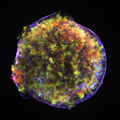From Wikipedia, the free encyclopedia
 Size of this preview: 480 × 480 pixels
Size of this preview: 480 × 480 pixels Full resolution (2,400 × 2,400 pixels, file size: 609 KB, MIME type: image/jpeg)
 |
This is a file from the Wikimedia Commons. The description on its description page there is shown below.Commons is a freely licensed media file repository. You can help.
|
 |
This is a featured picture, which means that members of the community have identified it as one of the finest images on the English Wikipedia, adding significantly to its accompanying article. If you have a different image of similar quality, be sure to upload it using the proper free license tag, add it to a relevant article, and nominate it. |
 |
This image was selected as picture of the day on the English Wikipedia for December 24, 2005. |
 |
This is a featured picture on English Wikipedia and is considered one of the finest images.
- If you think this file should be featured on Wikimedia Commons as well, feel free to nominate it.
- If you have an image of similar quality that can be published under a suitable copyright license, be sure to upload it, tag it, and nominate it.
|
 |
Summary
Tycho's Supernova Remnant. In 1572, the Danish astronomer Tycho Brahe observed and studied the explosion of a star that became known as Tycho's supernova. More than four centuries later, Chandra's image of the supernova remnant shows an expanding bubble of multimillion degree debris (green and red) inside a more rapidly moving shell of extremely high energy electrons (filamentary blue). Press Release. Also available at
As a huge ball of exploding plasma, it was Irving Langmuir who coined the name plasma because of its similarity to blood plasma, and Hannes Alfvén who noted its cellular nature. The filamentary blue outer shell of X-ray emitting high-speed electrons is also a characteristic of plasmas.
This is a false-colour x-ray image in which the energy levels (in keV) of the x-rays have been assigned a colours as follows: Red 0.95-1.26 keV, Green 1.63-2.26 keV, Blue 4.1-6.1 keV. All x-rays images must use processed colours since x-rays (as are radio waves, infra-red) are invisible to the human eye. But they are not invisible to suitable equipment, such as x-ray telescopes. The red and green bands highlight the expanding cloud of plasma with temperatures in the millions of degrees. The blue band shows a surrounding shell of extremely high energy electrons.
Credit: NASA/CXC/Rutgers/J.Warren & J.Hughes et al.
Licensing
|
|
This file is in the public domain because it was created by NASA. NASA copyright policy states that "NASA material is not protected by copyright unless noted". ( NASA copyright policy page or JPL Image Use Policy).
Deutsch | English | Español | Français | Galego | Nederlands | Português | Русский | 中文(简体) | 中文(繁體) | +/- |
|
|
|
Warnings:
- Use of NASA logos, insignia and emblems are restricted per US law 14 CFR 1221.
- The NASA website hosts a large number of images from the Soviet/ Russian space agency, and other non-American space agencies. These are not necessarily in the public domain.
- Materials from the Hubble Space Telescope may be copyrighted if they do not explicitly come from the STScI.
- All materials created by the SOHO probe are copyrighted and require permission for commercial non-educational use.
- Images featured on the Astronomy Picture of the Day (APOD) web site may be copyrighted.
|
Originally uploaded on the En-Wiki by en:User:Iantresman 12:40, 23 September 2005
File history
Click on a date/time to view the file as it appeared at that time.
|
|
Date/Time |
Thumbnail |
Dimensions |
User |
Comment |
| current |
21:57, 22 December 2005 |
 |
2,400×2,400 (609 KB) |
Solipsist |
|
|
|
21:52, 22 December 2005 |
 |
576×576 (293 KB) |
Solipsist |
|
File links
The following pages on Schools Wikipedia link to this image (list may be incomplete):




